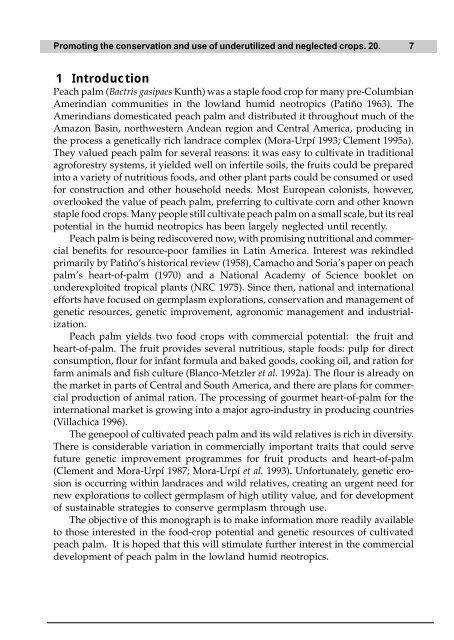Peach palm - World Agroforestry Centre
Peach palm - World Agroforestry Centre
Peach palm - World Agroforestry Centre
You also want an ePaper? Increase the reach of your titles
YUMPU automatically turns print PDFs into web optimized ePapers that Google loves.
Promoting the conservation and use of underutilized and neglected crops. 20. 7<br />
1 Introduction<br />
<strong>Peach</strong> <strong>palm</strong> (Bactris gasipaes Kunth) was a staple food crop for many pre-Columbian<br />
Amerindian communities in the lowland humid neotropics (Patiño 1963). The<br />
Amerindians domesticated peach <strong>palm</strong> and distributed it throughout much of the<br />
Amazon Basin, northwestern Andean region and Central America, producing in<br />
the process a genetically rich landrace complex (Mora-Urpí 1993; Clement 1995a).<br />
They valued peach <strong>palm</strong> for several reasons: it was easy to cultivate in traditional<br />
agroforestry systems, it yielded well on infertile soils, the fruits could be prepared<br />
into a variety of nutritious foods, and other plant parts could be consumed or used<br />
for construction and other household needs. Most European colonists, however,<br />
overlooked the value of peach <strong>palm</strong>, preferring to cultivate corn and other known<br />
staple food crops. Many people still cultivate peach <strong>palm</strong> on a small scale, but its real<br />
potential in the humid neotropics has been largely neglected until recently.<br />
<strong>Peach</strong> <strong>palm</strong> is being rediscovered now, with promising nutritional and commercial<br />
benefits for resource-poor families in Latin America. Interest was rekindled<br />
primarily by Patiño’s historical review (1958), Camacho and Soria’s paper on peach<br />
<strong>palm</strong>’s heart-of-<strong>palm</strong> (1970) and a National Academy of Science booklet on<br />
underexploited tropical plants (NRC 1975). Since then, national and international<br />
efforts have focused on germplasm explorations, conservation and management of<br />
genetic resources, genetic improvement, agronomic management and industrialization.<br />
<strong>Peach</strong> <strong>palm</strong> yields two food crops with commercial potential: the fruit and<br />
heart-of-<strong>palm</strong>. The fruit provides several nutritious, staple foods: pulp for direct<br />
consumption, flour for infant formula and baked goods, cooking oil, and ration for<br />
farm animals and fish culture (Blanco-Metzler et al. 1992a). The flour is already on<br />
the market in parts of Central and South America, and there are plans for commercial<br />
production of animal ration. The processing of gourmet heart-of-<strong>palm</strong> for the<br />
international market is growing into a major agro-industry in producing countries<br />
(Villachica 1996).<br />
The genepool of cultivated peach <strong>palm</strong> and its wild relatives is rich in diversity.<br />
There is considerable variation in commercially important traits that could serve<br />
future genetic improvement programmes for fruit products and heart-of-<strong>palm</strong><br />
(Clement and Mora-Urpí 1987; Mora-Urpí et al. 1993). Unfortunately, genetic erosion<br />
is occurring within landraces and wild relatives, creating an urgent need for<br />
new explorations to collect germplasm of high utility value, and for development<br />
of sustainable strategies to conserve germplasm through use.<br />
The objective of this monograph is to make information more readily available<br />
to those interested in the food-crop potential and genetic resources of cultivated<br />
peach <strong>palm</strong>. It is hoped that this will stimulate further interest in the commercial<br />
development of peach <strong>palm</strong> in the lowland humid neotropics.

















